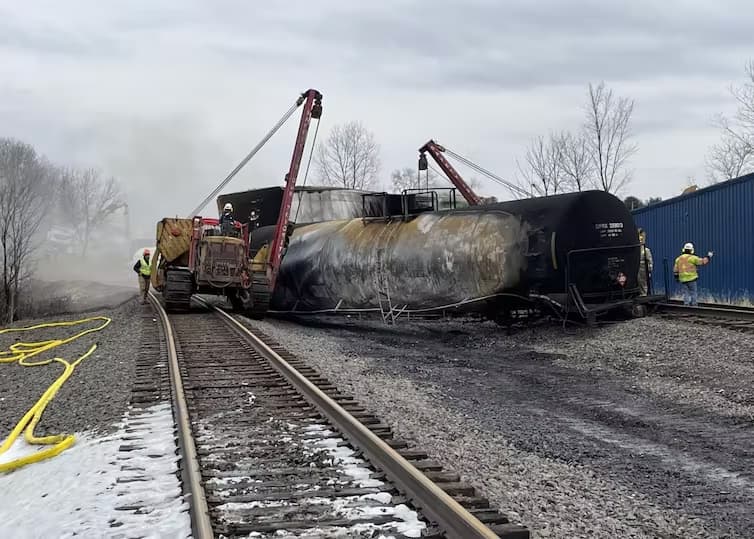Ohio Train Derailment: Toxic Chemical Lingering In Buildings

Table of Contents
Identifying the Toxic Chemicals
The derailment released a cocktail of hazardous substances, but some pose a more persistent threat due to their properties and potential for lingering in building materials.
Vinyl Chloride's Persistent Presence
Vinyl chloride, a known carcinogen, is a primary concern. Its volatile nature means it can easily seep into porous materials like drywall, insulation, and carpeting. This poses a significant risk for long-term exposure, even after the initial cleanup efforts.
- Carcinogenic Nature: Prolonged exposure to vinyl chloride is linked to an increased risk of various cancers, including liver cancer, brain cancer, and lung cancer.
- Health Risks: Beyond cancer, exposure can lead to liver damage, respiratory problems, and circulatory disorders.
- Difficult Removal: The pervasive nature of vinyl chloride makes complete removal from building materials extremely challenging and often necessitates extensive remediation, including demolition in severe cases.
- Detected Levels: While precise data on vinyl chloride levels in East Palestine buildings remains somewhat limited publicly due to ongoing investigations, reports indicate detectable levels in some affected areas, highlighting the need for further testing and remediation.
Other Contaminants of Concern
Beyond vinyl chloride, other chemicals released during the derailment pose lingering threats. These include, but are not limited to:
- Butyl acrylate: Known for causing skin and respiratory irritation. Its persistence in building materials is a subject of ongoing investigation.
- Ethylhexyl acrylate: Similar respiratory and skin irritants, with potential long-term health concerns.
- Ethylene glycol monobutyl ether: Can cause kidney and liver damage, and its presence within buildings requires careful monitoring.
Ongoing testing for these substances is crucial to fully understand the extent of contamination and inform remediation strategies. The complexity of detecting low levels of these chemicals in various building materials adds to the challenge.
The Challenges of Detection and Measurement
Accurately measuring low levels of these chemicals in buildings is complex and requires specialized techniques.
- Air Sampling: This method detects airborne concentrations but may not reflect levels absorbed into building materials.
- Material Sampling: This involves taking samples of drywall, insulation, carpeting, and other materials for laboratory analysis. However, this can be invasive and costly.
- Limitations: Current testing methods may not capture all potential contaminants or accurately measure very low concentrations. Comprehensive and ongoing monitoring is vital.
Impact on Residents and Businesses
The Ohio train derailment's consequences extend far beyond the immediate aftermath, significantly impacting the health, economy, and social fabric of East Palestine.
Health Concerns and Symptoms
Residents have reported a range of health issues potentially linked to chemical exposure:
- Respiratory Problems: Coughing, shortness of breath, and wheezing are common complaints.
- Skin Irritation: Rashes, itching, and burning sensations have been reported.
- Headaches and Dizziness: These symptoms are also frequently mentioned by residents.
- Long-Term Monitoring: A comprehensive, long-term health monitoring program is essential to track the long-term effects of exposure.
Economic and Social Impacts
The derailment has caused substantial economic and social disruption:
- Property Devaluation: The stigma of contamination is impacting property values, creating financial hardship for residents.
- Business Closures: Businesses have been forced to close due to contamination, evacuation orders, or reduced customer traffic.
- Displacement: Some residents have been displaced from their homes, facing relocation challenges and emotional distress.
- Social Disruption: The event has created significant anxiety and uncertainty within the community, affecting social cohesion.
Cleanup Efforts and Remediation Strategies
Cleaning and remediating buildings contaminated by the chemical spill is a complex and ongoing process.
Cleaning Contaminated Buildings
Various techniques are employed, each with its limitations:
- Air Scrubbing: This involves using specialized equipment to remove airborne contaminants.
- Specialized Cleaning Products: Specific cleaning agents are used to decontaminate surfaces, but their effectiveness varies depending on the contaminant and material.
- Demolition: In cases of severe contamination, demolition of affected structures may be necessary.
The process is often iterative, requiring multiple rounds of testing and remediation.
Government Response and Accountability
Federal, state, and local governments have a crucial role to play in cleanup and support:
- Regulatory Actions: Agencies are investigating the cause of the derailment and implementing new regulations to prevent future incidents.
- Funding Allocations: Significant funding is needed for cleanup, health monitoring, and economic recovery efforts.
- Ongoing Investigations: Thorough investigations are necessary to determine accountability and prevent similar disasters.
Long-Term Health and Environmental Monitoring
The long-term effects of the derailment on both human health and the environment require sustained monitoring.
The Need for Continued Surveillance
Long-term health monitoring is paramount for exposed residents:
- Epidemiological Studies: These studies are crucial to identify patterns and long-term health effects.
- Regular Health Screenings: Residents need access to regular medical checkups and specialized screenings.
- Access to Medical Care: Ensuring access to quality healthcare for affected individuals is essential.
Environmental Impact Assessment
Continued environmental monitoring is vital to assess the lasting impact:
- Soil and Water Testing: Regular testing is needed to determine the extent of soil and water contamination.
- Wildlife Monitoring: Observing the health and behavior of local wildlife can provide insights into the environmental impact.
- Long-Term Contamination: The potential for long-term environmental contamination requires sustained vigilance and remediation efforts.
Conclusion
The Ohio train derailment and the lingering presence of toxic chemicals in East Palestine buildings represent a continuing crisis with profound implications for the health and well-being of the community. Addressing the immediate concerns about contamination, ensuring comprehensive cleanup efforts, and providing long-term health monitoring are critical steps in mitigating the damage. Further investigation and accountability are necessary to prevent future incidents and protect vulnerable communities. Stay informed about the latest developments regarding the Ohio train derailment and the ongoing efforts to address the lingering threat of toxic chemicals. Regularly check for updates on the health and environmental impacts, and demand transparency and accountability from those responsible.

Featured Posts
-
 Ariana Grandes Dramatic Hair And Tattoo Transformation
Apr 27, 2025
Ariana Grandes Dramatic Hair And Tattoo Transformation
Apr 27, 2025 -
 Controversial Hhs Decision Anti Vaccine Activist To Investigate Disproven Autism Vaccine Claim
Apr 27, 2025
Controversial Hhs Decision Anti Vaccine Activist To Investigate Disproven Autism Vaccine Claim
Apr 27, 2025 -
 Ariana Grande Lovenote Fragrance Set Online Purchase Guide And Price Check
Apr 27, 2025
Ariana Grande Lovenote Fragrance Set Online Purchase Guide And Price Check
Apr 27, 2025 -
 Eqs Pvr Pne Ag Veroeffentlicht Gemaess 40 Abs 1 Wp Hg
Apr 27, 2025
Eqs Pvr Pne Ag Veroeffentlicht Gemaess 40 Abs 1 Wp Hg
Apr 27, 2025 -
 Understanding Ariana Grandes Recent Hair And Tattoo Choices A Professional View
Apr 27, 2025
Understanding Ariana Grandes Recent Hair And Tattoo Choices A Professional View
Apr 27, 2025
